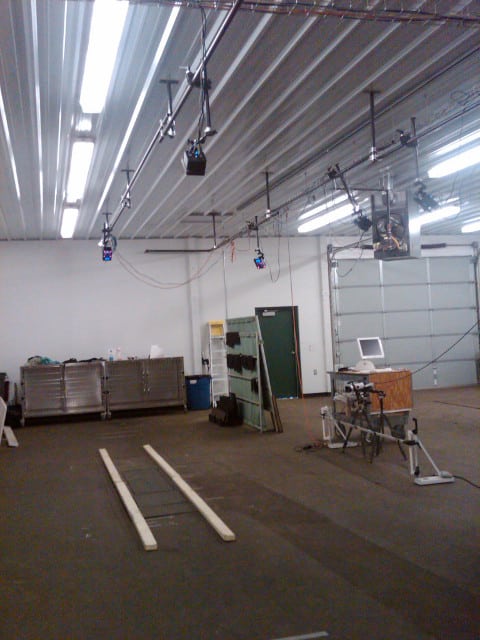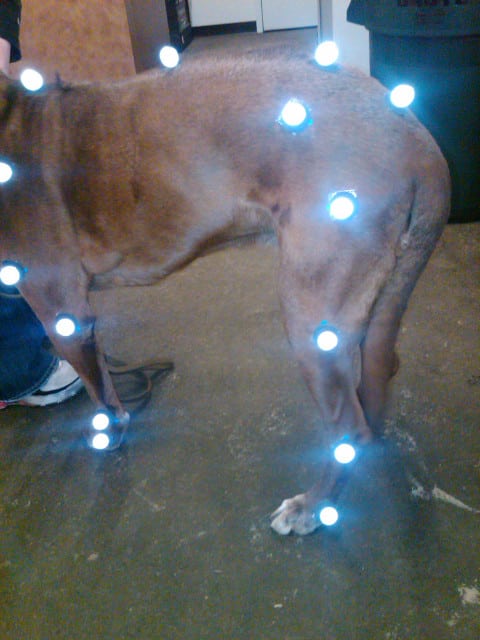The “Tripawd hop” is an endearing trait that we’re all familiar with, but it doesn’t come without repercussions on an animal’s body.
Two recent canine amputee gait studies by Colorado State University took a closer look at the biomechanical changes that occur in amputee dogs, in order to help further research that will develop alternative limb-preserving procedures for dogs:
“Kinematic and kinetic analysis of dogs during trotting after amputation of a thoracic limb”
and
“Kinematic and kinetic analysis of dogs during trotting after amputation of a pelvic limb”
We asked one of the study’s leaders, assistant professor of surgical oncology Dr. Deanna R. Worley, DVM,to tell us a bit more about these two fascinating studies. Here’s our email conversation:
Dr. Worley, why did your team study the gait of dogs who’ve lost a limb?

Trotting gait was used because it had not previously been evaluated in amputee dogs. In the clinics when I have the pleasure of examining and treating our amputee patients, they typically move so quickly…it is rare to see one strolling in at a leisurely walk. I smile as I frequently find myself being pulled down the hallway by exuberant amputee dogs!
From a scientific perspective, using a faster trotting gait for analysis, there was thought that there would be more force exerted on each leg than at a walk and possible periods where the dog would be supported by one limb. We found in thoracic limb amputee dogs, they adopt their own unique gait pattern to move which is a blend of a walk, trot and gallop. This pattern is not seen in quadruped dogs.
The study found that the remaining thoracic and pelvic limbs in forelimb amputees take on more braking force when trotting. What does this mean for the long-term physical health of these dogs? Are there things we can do to minimize the impact on the other limbs?
The most important things to do to minimize impact on other limbs is keeping your dog in as good as health as you can, particularly maintaining a healthy weight, and creating a home environment that is not difficult for your dog to navigate. This includes non slip flooring, comfortable stair steps (no extreme rise and run of constructed stairs), moderate level of physical activity, and ongoing therapy for any concurrent osteoarthritis.

Were dogs of all sizes enrolled in the studies? If so did you notice a difference in the gait analysis results of larger dogs versus smaller dogs?
Dogs needed to be greater than 30 pounds body weight for inclusion to the study. The practical reason was because the pressure plates the dogs walked over couldn’t easily be adjusted/shortened for smaller dogs with short strides. Clinically we have not observed any difference in amputation outcomes between giant and large breed dogs versus smaller and medium breed dogs. We were criticized during the review process of our articles for performing amputations in larger dogs, even though the published body of knowledge does not support the opinion that larger dogs adapt less well to a limb amputation.
I’m curious about this comment in the Thoracic Limb Gait Study: “Although not evident in the present study, it is possible that complete adaptation to limb amputation may require longer than 1 month and that additional gait alterations ad compensatory strategies may place these dogs at increased risk for musculoskeletal injury in one of the remaining limbs.” I know your answer would mostly be a guess, but in your expert opinion, what types of things can pet parents do (or avoid) to help our dogs make that transition to three legs without risk of injury? Would the risk of injury be the same for front and rear limb amputees?
What I’ve observed in recent years is the transition in amputee dogs from a four-legged state to a three-legged state can be improved and shortened with incorporation of physical therapy performed by trained veterinary physical therapists. There is some thought that with the same amount of activity being born by joints in three legs instead of four, that there is increased wear and use of those remaining joints which can theoretically increase risk and or progression of osteoarthritis.

Do you have any plans for future studies about three-legged dogs? How can we as a community support/donate to work like this to ensure the long term health of future canine amputees?
The goal of the present studies was to provide a thorough description of the biomechanical changes that occur in amputee dogs and to use that as a comparison for further research exploring alternative limb-preserving procedures.
Let’s all give a round of 3-paws up to Dr. Worley and the team at CSU for helping to make life better for three-legged animals and their humans!
 Join the forum discussion on this topic!
Join the forum discussion on this topic!
I have been worrying about Gracie’s gait (foreleg amp); she seems to slighty favor the back leg diagonally opposite her missing leg. I noticed this when we first adopted her (3 weeks post amp) and I notice it still. I have taken her in for a knee assesment to a well repsected orthopedic vet and he didn’t see anything odd that wouldn’t be explained by her weight distribution. He didn’t feel the need to xray. My regular vet thought maybe a partial CCL tear and had us put her on severely restricted activity and Rymadil for 4-6 weeks. We have done that and she still has her funny, hopping gait, with an occassional mis-step with that leg and a sort of odd “swinging-wide” of that leg. Additionally she doesn’t seem to put full weight on that leg often when she is standing still (when eating for instance). I was heartened to see the video of the other foreleg amputee in this article. His “hop” is just like Gracie’s. And, I hope she is just fine.
I am curious if any part of this study or any other research has compared the biomechanics of dogs that have undergone amputations vs. dogs that were born with limb deformities causing them to be three-legged.
Great question Megan! I will forward this to CSU’s team.
Megan, I heard back from Dr. Worley, she says “I am not aware of any gait study looking at kinetics and or kinematics of limb deformity dog patients.”
Sounds like something the Tripawds N ation should definitely try to fund some day!